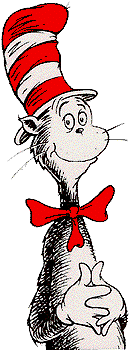Lions and Tigers and Bears, Oh My!
Purpose
To design a Zoo, utilizing the strategies learned in previous labs and
lectures, such as abstract classes, combined with a new class of self-referential
data, a list. This lab intends to show how you can combine these two strategies
to easily implement even complicated class heirarchies by thoroughly thinking
through the data definition and knowing how to implement that definition
in the frameworks of Java.

|
|
Part 1 - Who let the Dogs out?
In the first section of the lab, you should download the code (exe)
for the project. This code already includes both of the jar files
needed to get the project running in Metrowerks as well as the Metrowerks
project file and all the fixins. Yummy! The code should look familiar,
a large part of it was done in the previous lab. Look over this
code and if there are any questions, ask the nearest TA or tutor
for help. The code should run and display some "pretty boxes" without
any modification. The project currently has an implementation of
the Animal class heirarchy we developed last time.
|
Part 2 - One Fish, Two Fish, Red Fish, Blue Fish
But we don't want to only be able to deal with single animals! What
if we are starting a large collection of lions? We want to be able
to add these lions to a long list of lions and then search that
list for a lion with a particular name, Simba for example. How do
we do this? We need self-referential data! What is self-referential
data? Self-referential data is data that is defined in terms of
itself. This is how we will view our list. After some data analysis,
we discover that there are two kinds of Lists, EmptyLists
and NonEmptyLists (we will use Cons and Empty). This discovery
should remind of us something. A list is one of two types, in the
same way that an animal was one of three types! We have a parent
and a child class! Do some data analysis and method analysis on
each of the child classes.
- What do they have that is different from one another?
- What types of things are the same?
- What belongs in the parent class List?
- What goes in only one of the two children, either ConsLion
or EmptyLion?
- What does the UML Diagram look like?
|
|

|

|
|
Part 3 - Have a little help from our friends
We now have the two classes, the implementation of all the basics
we need for a List of lions. But it seems pretty useless
unless we create a few extra methods to be able to process these
lists of ferocious Kings of the Jungle.
Come up with a few ideas of some methods that would be useful for
this List of lions. If you're having trouble, consider the
following.
- What if we want to print the list of lions in order by their
name?
- How can we determine if Simba is still in his cage, or if he's
no longer with the rest of the lions?
- Can we easily find the heaviest lion, or the lightest?
- If we decide to make lion steaks, how many pounds will we have
using all the lions?
Implement a solution to one of the above problems. If you're ambitions,
implement solutions to all of them! They all could be very useful
and possibly prevent someone from being eaten!
|
Part 4 - Animal House
It's all very good to have a list of lions, but we still haven't
reached our true goal. We want to create a zoo, not just a list
of lions. It may look as if we have to start all over again, but
because of our careful data analysis and use of a class heirarchy,
the change isn't so hard to make!
- What is the main difference between our two lists?
- Does this lead to a lot of changes?
- Does the fact that lion is a subclass of animal help us at all?
|
|

|
Conclusion
We have walked through the design and implementation of a problem involving
complicated data. Not only do we have self-referential classes of data,
but also class heirarchies. The Data Analysis was a difficult task, but
once completed lended itself easily to the implementation of the classes.
In addition, this well thought out Data Analysis also leads to structured
data that others can understand, as well as a program that is easily adaptable.



